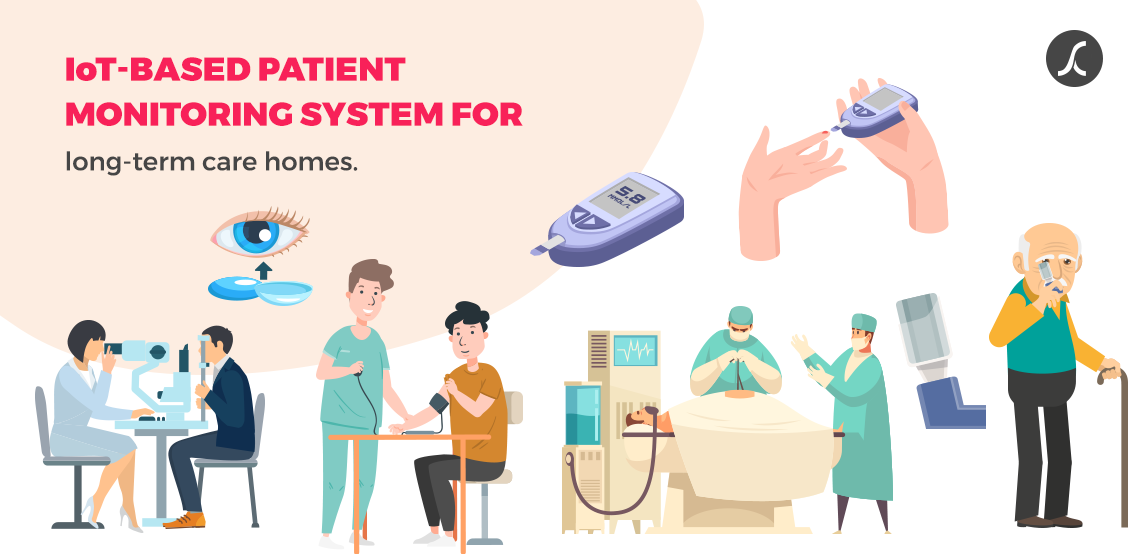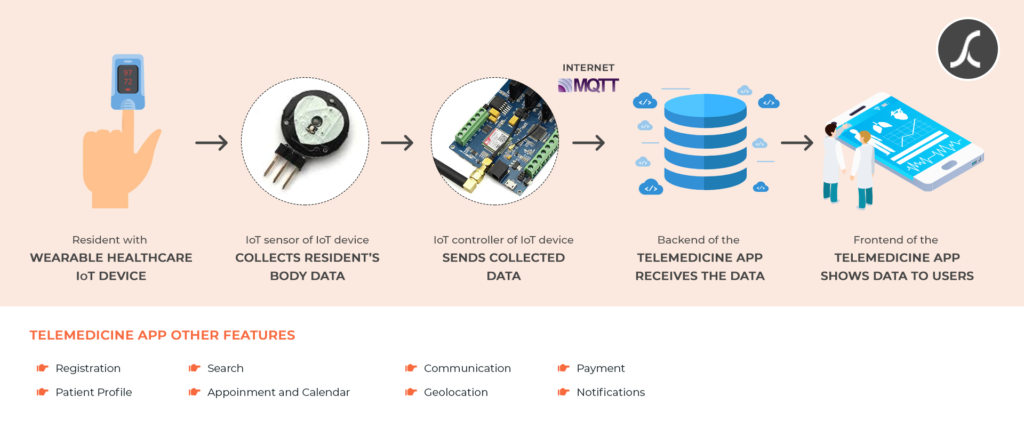How to set up an IoT-based remote patient monitoring system for long-term care homes in Canada with a telemedicine app?

5 years ago
Our healthcare system is overwhelmed and healthcare professionals working in it are overburdened.
During a healthcare crisis like COVID-19, healthcare professionals are at the highest risk. Quick adoption of the right technology can definitely save the life of front-line staff members.
Talking about long-term care homes in Canada, they should immediately ramp up their efforts to combat COVID-19 as they are accommodating the most vulnerable age group to coronavirus.
At present, deployed technology at most of the long-term care facilities in Canada is insufficient to provide quality senior care during the pandemic and even after this.
Clinicians looking after residents of the long-term care facilities face many real challenges.
They can’t store residents’ medical data electronically. They can’t treat more residents in less time. They can’t even diagnose residents properly.
Because of this many system incompetencies, long-term care home facilities in Canada lack behind when it comes to connected care and quality care.
But there is one affordable and purposeful solution that solves all challenges of clinicians. Yes, we are talking about an IoT-based remote patient monitoring system.
In this blog, we will discuss everything you need to know to deploy an IoT-based patient monitoring system to store residents’ medical data automatically & electronically and to enable clinicians to look after more residents with more effectiveness and in less time.
Our other useful resources for LTC homes:
- Telemedicine solution for long-term care homes
- How an LTC home reduced the administrative burden by 63%?
What is an IoT-based remote patient monitoring system?
To collect patients’ body data such as blood pressure, oxygen level, glucose level, physicians have to manually collect data by using different healthcare equipment.
And for that, physicians have to visit patients. Furthermore, data collected by the manual process requires efforts to store data online to analyze patients’ conditions more efficiently.
An IoT-based patient monitoring system eliminates these challenges.
When you deploy an IoT-based patient monitoring system at your long-term care homes, the healthcare IoT devices which are equipped with IoT sensors automatically collect residents’ body data and store that data in the database which can be viewed by authorized users such as physicians, DOC, RP, RPN from the mobile app.
In other words, IoT-based patient monitoring system measures, records, distributes and shows the biometric values. Biometric values include heart rate, SPO2, blood pressure, temperature and more.
One of the major advantages of the IoT-based patient monitoring system is its affordability.
In an IoT-based patient monitoring system, small IoT devices that are affordable offer you flexibility and actualize the complete IoT-based remote patient monitoring system.
How does an IoT-based remote patient monitoring system work?
An IoT-based remote patient monitoring system works partially differently than you experience patient-monitoring in the intensive care unit.
In a remote IoT-based patient monitoring system, there are 4 major components. These components are IoT devices, a data communication channel, a mobile app backend, and a mobile app frontend.
- IoT devices: IoT devices are equipped with IoT sensors that collect the residents’ biometric data manually or automatically after a certain time interval.
- Data communication channel: The IoT controller fitted in an IoT device sends collected data over the Internet by using the MQTT protocol to the backend of the mobile app.
- The backend of the mobile app: The backend of the mobile app receives the biometric data of residents sent by the IoT controller, processes it, and shows it to users through the frontend of the mobile app.
- The frontend of the mobile app: The frontend of the mobile app which is the user interface shows the collected data to the users.
Now, you might have a question that how a user can control the IoT device that collects a resident’s biometric data.
How can you control the healthcare IoT device?
Like the IoT controller of an IoT device sends collected data to the backend of the app through the Internet which you later view through the frontend, you can also send a command to IoT controller through the frontend of the mobile app which IoT controller receives through the backend of the mobile app.
As soon as the IoT controller receives the command, it processes it as it has the memory and computing power and then it makes the IoT device act according to your command.
Which are the top healthcare IoT devices for a remote patient-monitoring system of long-term care homes?
There are many healthcare IoT devices or sensors available in the market. But since each IoT device collects different body data of residents, you should first decide the body data you want to collect remotely and then decide the IoT devices you need to own to actualize a remote IoT-based patient monitoring system for long-term care homes.
The following are the top healthcare IoT devices you probably require for long-term care homes.
- Smart inhaler: This device helps physicians understand asthma and COPD symptoms, track uses of rescue medication, and it also provides allergen forecasts.
- A Continuous Glucose Monitor: This IoT device helps diabetics and physicians to continuously monitor blood glucose levels.
- Blood pressure measurement: This device actively measures the blood pressure of the residents. This one is the most important IoT device for remote senior care.
- Fingertip pulse oximeter: This device measures the pulse rate and how much oxygen is in a resident’s body.
Why should you deploy an IoT-based remote patient monitoring system in long-term care homes?
There are many reasons or advantages why deploying an IoT-based patient monitoring system in long-term care homes is a safe bet. But the following are the most game-changing reasons or advantages.
- Physicians can collect body data of residents’ without visiting them.
- Physicians can provide remote care more effectively.
- Physicians can look after more residents in less time.
- Physicians can study the historic medical data of residents.
- During the healthcare crisis like COVID-19, physicians can avoid direct contact with residents without affecting the ‘quality senior care’.
Deploying IoT-based patient monitoring system smartly, with telemedicine app

When you deploy an IoT-based remote patient monitoring system, you definitely need a mobile app to read the reading of IoT devices.
So, why don’t you deploy an IoT-based patient monitoring system with an integrated telemedicine app?
This is the smart decision. By doing so, you will be able to derive benefits offered by a telemedicine app as well as a patient monitoring system.
And most importantly, this smart decision does not influence your budget dramatically.
A telemedicine app is very purposeful. It lets you store a resident's medical history, arrange virtual visits with physicians, write e-prescription, and many more.
How can we help long-term care homes to deploy an IoT-based remote patient monitoring system with a telemedicine app?
We can truly modernize your long-term care home and allow you to experience how data can enrich senior care results.
After studying your requirements, we will set up the complete IoT-based remote patient monitoring system including all IoT devices.
We have already developed a telemedicine app named Writi. Writi is equipped with disruptive features for all healthcare professionals working in long-term care homes such as RN, RPN, physicians, DOC, and even pharmacies.
We have engineered Writi in such a way that it can easily store and let you view data recorded by the IoT devices, directly from Writi.
We will enable you to double the benefits by deploying a telemedicine app as well as a patient monitoring system while satisfying your budget.
On the concluding note, we would also like to share our white-label telemedicine app which we can integrate with any patient monitoring system.
